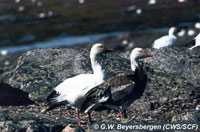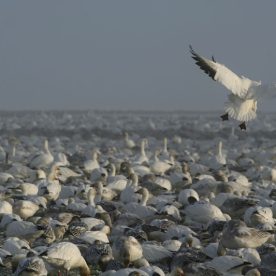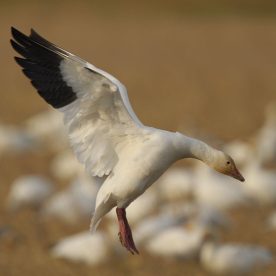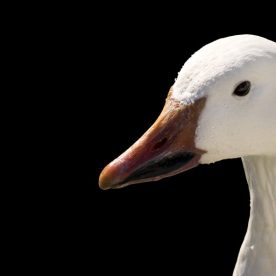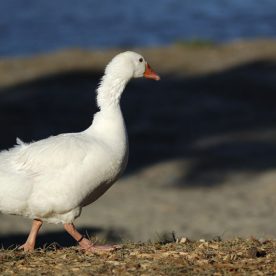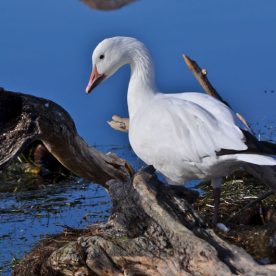Description
The Lesser Snow Goose Chen caerulescens caerulescens has two different appearances, white phase and blue phase. The plumage of white-phase geese is almost completely white, except for black wing tips. The blue-phase goose has a white head, a bluish colour on the feathers of the lower back and flanks, and a body that ranges in colour from very pale, almost white, to very dark. Both the white- and blue-phase snow geese frequently have rusty orange faces, because their feathers have been stained by iron in the earth where the birds feed.
The downy goslings of the white-phase geese are yellow, those of the blue phase nearly black. By two months of age the young birds of both colour phases are grey with black wing tips, although the immature blue-phase birds are generally a darker grey and have some light feathers on the chin and throat, which can become stained like those of the adults. The goslings have mostly lost their grey coloring by the following spring; in April and May they may only show a few flecks of darker coloring on their head and neck, and a few grey feathers on their wings that distinguish them from adults.
By the spring the black to dark grey bills of the immature birds have become grey-pink. The bill of the adult is pink and is narrower than the broad, black bill of the Canada Goose. It has evolved to enable the geese to eat the nutritious roots of marshland plants. The serrated black edge of the bill makes the bird appear to be smiling and is sometimes called the “grinning patch.”
The Lesser Snow Goose has a wingspan of about 90 cm and its average weight is 2.2 to 2.7 kg, the male being larger.
There are two other types of white geese found in North America: the Greater Snow Goose Chen caerulescens atlantica, and Ross’ Goose Chen rossii. The Greater Snow Goose is slightly larger than the Lesser Snow Goose and nests farther north and east; blue-phase Greaters are rarely seen. The Ross’ Goose is much smaller than the Lesser Snow Goose and does not have a grinning patch on the side of the bill. Blue-phase Ross’ Geese are rare. As the numbers and ranges of both species have increased during the last 50 years, hybrids between them have become quite frequent. The hybrids are intermediate in size between Ross’ Geese and Lesser Snow Geese.
Signs and sounds
The Lesser Snow Goose makes a loud, resonant, nasal whouk or houck, which can sound like a high-pitched bark, often uttered in chorus.
Habitat and Habits
The Lesser Snow Goose Chen caerulescens caerulescens has two different appearances, white phase and blue phase. The plumage of white-phase geese is almost completely white, except for black wing tips. The blue-phase goose has a white head, a bluish colour on the feathers of the lower back and flanks, and a body that ranges in colour from very pale, almost white, to very dark. Both the white- and blue-phase snow geese frequently have rusty orange faces, because their feathers have been stained by iron in the earth where the birds feed.
Each spring and fall undulating lines of brilliant white geese with black-tipped wings fly over southern Canada. The strength and beauty of these birds, as they wing their way between arctic breeding areas and temperate wintering habitat, bring pleasure to many people.
Most of the migrating white geese that are seen over southern Canada west of Quebec are Lesser Snow Geese, although smaller white geese, Ross’ Geese, mingle with the prairie flocks. Migrating white geese seen in southern Quebec are more likely to be Greater Snow Geese; however, some Lesser Snow Geese travel over the province with the flocks of Greater Snow Geese and, along with them, break their migratory flights at Cap Tourmente on the St. Lawrence River. In the Atlantic provinces, migrating snow geese are seen only occasionally.
People who live in the lower mainland of British Columbia can not only see Lesser Snow Geese on migration, they can also observe the geese on their wintering grounds. This is because part of the large Lesser Snow Goose population that North America shares with eastern Asia winters in British Columbia’s Fraser River delta—after breeding 4 000 km away on Wrangel Island in the Soviet Arctic.
Lesser Snow Geese are usually seen in very large flocks and are always quite vocal. When flying they stay together in large groups, but they do not generally fly in Vs like Canada Geese. Instead they form lines or U formations that change shape frequently. Because of the apparent waving motion of the flying lines, snow geese are sometimes known as “wavies.”
Unique characteristics
Because most marshland plants store their energy reserves in their roots in winter months, Lesser Snow Geese have evolved strong serrated bills to cut and tear the roots of bulrushes and sedges from the ground in coastal marshes. The goose holds the plants with the serrated edge so that its powerful, toughened tongue, which is also serrated along the margins, can cut through them.
Range
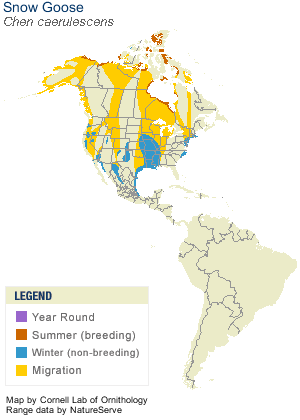
Surprisingly, in an age of declining wildlife populations, Lesser Snow Geese have increased dramatically in number since the mid-1970s, and in North America, they can probably be considered the single most abundant goose. Currently, more than 5 000 000 nest in Canada, along the coast of Hudson Bay, from Cape Henrietta Maria in Ontario to Keewatin; on Southampton Island and on southern Baffin Island, Nunavut, and in northern Mackenzie and Keewatin south of Queen Maud Gulf, Nunavut; and on Banks Island in the Northwest Territories. The other major concentration of breeding Lesser Snow Geese in the world is the one on Wrangel Island in eastern Siberia, where there are now about 100 000 birds.
Although most Lesser Snow Geese nest in Canada, only 20 000 to 40 000 winter in this country—in south-coastal British Columbia—and they originate on Wrangel Island. Birds nesting in the Canadian Arctic winter in central California, New Mexico, the interior highlands of Mexico, and along the Gulf of Mexico, both on the coast and, increasingly, in inland areas.
Because Lesser Snow Geese breeding in Canada are spread over such a vast area, they take many different routes between their breeding and wintering areas. Lesser Snow Geese breeding in the western Arctic form pre-migration staging flocks in the Mackenzie River delta and along the north coast of Yukon and Alaska. On migration they fly up the Mackenzie River, through Alberta and western Saskatchewan and on to central California or the interior of Mexico.
Birds from the eastern Arctic stage in very large numbers on the Canadian prairies before heading farther south. During migration they pass through the midcontinental U.S., on a rather broad front, en route to parts of the southern U.S. and the coast of the Gulf of Mexico.
Major shifts in autumn distribution have taken place since 1975. Large numbers of eastern arctic birds formerly staged along the coast of James Bay before many made a non-stop migration to the Gulf coast. Since that time, fewer birds stage in James Bay, and migration proceeds in stages through the Canadian prairies and extending through the midcontinental United States. Most lesser snow geese now stage in Saskatchewan before leaving Canada, with smaller numbers staging in Manitoba and Alberta before departing southward.
Birds from Wrangel Island in Siberia fly across the Bering Strait to Alaska and down the west coast of British Columbia to major wintering areas on the Fraser River, the Skagit River in Washington, and in central California. Some, also bound for California, fly up the Mackenzie River and through Alberta.
We know less about the spring migration routes, which appear to be similar to those in fall, but with some shifts between corridors. Birds returning to Wrangel Island tend to fly along the British Columbia coast, but some of the Wrangel Island population also uses an interior route through Montana, Alberta, Saskatchewan, Northwest Territories, and interior Alaska. Birds of western Canadian origin wintering in California fly north through Alberta, then down the Mackenzie valley to the western Arctic coast. Birds returning from the coast of the Gulf of Mexico fly up the Mississippi and Missouri river valleys to important staging areas in southwest Manitoba, southern Saskatchewan, and western Alberta before proceeding northward to nesting areas in the central and eastern Arctic.
Birds from the eastern Arctic stage in very large numbers in James Bay and on the west coast of Hudson Bay before heading farther south. During migration they pass through Manitoba and Ontario, on a rather broad front, en route to the coast of the Gulf of Mexico.
Major shifts in autumn distribution have taken place in prairie Canada since 1975. In that year 50 000 to 100 000 Lesser Snow Geese started to use a more westerly route through eastern Saskatchewan. The shift from southwestern Manitoba to eastern Saskatchewan continued in subsequent years. This means that birds from the central Arctic fly in two directions: one southwestward corridor takes them into Alberta and western Saskatchewan; another southeastward corridor goes through southern Manitoba.
Birds from Wrangel Island in Siberia fly across the Bering Strait to Alaska and down the west coast of British Columbia to major wintering areas on the Fraser River, the Skagit River in Washington, and in central California. Some, also bound for California, fly up the Mackenzie River and through Alberta.
We know less about the spring migration routes, which appear to be similar to those in fall, but with some shifts between corridors. Birds returning to Wrangel Island tend to fly along the British Columbia coast, but some of the Wrangel Island population also uses an interior route through Montana, Alberta, Saskatchewan, Northwest Territories, and interior Alaska. Birds of western Canadian origin wintering in California fly north through Alberta, then down the Mackenzie valley to the western Arctic coast. Birds returning from the coast of the Gulf of Mexico fly up the Mississippi and Missouri river valleys to an important staging area southwest of Winnipeg and then in a more-or-less straight northeasterly line to James Bay and the Hudson Bay coast and north into the eastern Arctic.
Feeding
On its Arctic breeding grounds the Lesser Snow Goose feeds on grasses and sedges. On migration, corn, peas, and cereal grains like wheat and barley increasingly form the main part of the diet, although birds migrating along the west coast still rely on traditional estuarine plants. During the winter on the Fraser River delta, the geese also feed on pasture grasses and fall rye. In wintering areas along the Gulf of Mexico, the birds have traditionally fed on tubers, roots, and grasses in coastal marshes; however, in about 1960, some of this wintering population began to feed farther inland on cultivated corn, rice, and grain—both on fall-sown crops and on the waste grain left by bigger harvesting equipment. In spring, Lesser Snow Geese put on much weight by feeding voraciously on agricultural waste corn and grain.
From the time they hatch, goslings, or young, feed almost completely on growing shoot tips of grasses and sedges, which offer a relatively high protein diet that is easily digested by their developing digestive systems.
Breeding
Lesser Snow Geese, unlike most other waterfowl, usually nest close to each other in large colonies with densities that can exceed 5 000 pairs per square kilometre. When snow geese first return to their breeding colony the ground is often still snow-covered. But snow geese are well adapted to wait for the thaw of ice and snow in order to nest. In spring they carry heavy loads of fat and protein in their body reserves and can live on these for up to two weeks, though where possible they feed on emerging vegetation. As the snow begins to melt, the flock breaks into smaller groups and eventually into pairs.
Nesting starts as early as northern snow conditions allow and varies between colonies. Depending on latitude, egg-laying begins from early May to mid-June. If delayed by snow cover after June 20, the geese do not breed; instead, they resorb their eggs and wait until the next year.
The nest itself consists of a scrape in the moss or gravel that often becomes built up into a mound over the years with bits of moss, willow, and grasses. Some down, or fine feathers, is added to the nest bowl as the eggs are laid. From two to six eggs are produced, with the average clutch size being around four. Incubation, or sitting on the nest to keep the eggs warm until they hatch, begins when the last egg is laid and continues for about 23 days. The lapse of time varies according to the number of eggs produced, and peak hatching can occur from early June in James Bay to mid-July in high arctic colonies. Eggs in the more southern colonies generally hatch earlier than those in the north.
Only the female incubates. The male remains nearby to protect the female and nest from predators and from other geese looking for a ready-made home. The female leaves the nest for only a few minutes each day, and in the latter part of the incubation period she may not leave at all. As a result she is very thin by the time hatching begins; she may lose up to 30 percent of her body weight, which she regains when she starts to feed with the goslings.
After all the young birds have hatched they may stay together in the nest for up to 24 hours. When they have dried off they leave the nest, together with both parents, and begin to feed. The young geese must grow very quickly in order to be large enough to fly south before the Arctic winter returns.
From an initial weight of about 100 g at hatch the young grow to more than 1 200 g in six to seven weeks. While the young are still small both adults moult, or shed, their flight feathers, the males a week or so ahead of the females. Subadults and failed breeders moult two to three weeks before successful parents. Some goslings and their parents walk and swim up to 50 km during the eight-week period from hatching to fledging, or first flight. Both the young and the adults must spend most of their time feeding in order to grow large enough to fly or to regain their flight feathers by mid-August. The family group gains its power of flight at the same time.
Snow geese show a very strong family bond. The young and adults remain together throughout the winter and the spring and fall migrations. The family generally breaks up when the parents start a new nest; however, sometimes the young of the previous year rejoin the new family.
Conservation
The Lesser Snow Goose is the most highly studied of the Arctic-nesting geese. Much has been learned about it, but there are still many things that are unknown. Its population has increased steadily over the last 50 years, probably for several reasons. The increase in winter food due to changing agricultural practices in the southern United States is probably the most important cause. Climatic changes in the Arctic may also have helped, earlier spring snow melt in the eastern Arctic having enabled the geese to occupy new areas on Baffin Island and on the mainland District of Keewatin.
The increased population is creating problems both for the Lesser Snow Goose and for people. When large numbers of geese concentrate in relatively small areas, they may deplete their natural food supplies. In coastal salt marshes along James Bay and southern Hudson Bay, lesser snow geese have denuded areas through their intensive foraging activities, which involve ‘grubbing’ for the below-ground portions of grasses and sedges in spring. Roots and rhizomes of salt marsh and freshwater grasses contain abundant carbohydrates in spring, and snow geese actively seek these resources while feeding. At McConnell River, on the west coast of Hudson Bay, a colony of about 200 000 breeding geese has denuded the original nesting area of edible vegetation so that little more than bare soil remains. On some colonies, including a recently established one on Jenny Lind Island, there may be too many geese for the food resources available.
When the geese turn to agricultural crops in the south, they do not confine themselves to waste grains, but may cause damage to winter wheat and important grasslands. There is also the possibility of disease outbreaks when large numbers of birds are confined to small areas. In several recent years epidemics of avian cholera have killed many Lesser Snow Geese at spring staging areas in the central United States and in breeding colonies on the west coast of Hudson Bay, on Banks Island, and in the central Arctic.
Because of their abundance and wide distribution in southern Canada on fall migration and in the United States in the late fall and winter, many snow geese are shot by hunters. They are an important source of food for some northern people, especially the Cree Indians living around James Bay, at times when other sources of fresh meat are scarce or inaccessible. In the decade between 1999 and 2009, hunters reported taking more than 1 million geese per year in Canada and the United States combined.
Current research includes studies of the reproductive biology of the geese; of migratory routes and the timing of migration; and of food habits and the effects the geese have on the plants that constitute their food. Waterfowl managers are primarily concerned with the high numbers of Lesser Snow Geese, the quantity and quality of habitat available to them throughout their life cycle, and the impacts they may have on sensitive arctic and subarctic habitats used for feeding. Ongoing surveys and banding programs provide information about changes in population size, distribution, annual survival, and harvest rates.
Efforts are continually being made to protect critical habitats. Migratory Bird Sanctuaries have been set aside to protect nesting colonies on the Anderson River delta, Kendall Island, and Banks Island in the Northwest Territories and the Queen Maud Gulf, Southampton Island, Baffin Island, and the McConnell River in Nunavut. Wrangel Island in Russia is also a protected area. Many snow geese also winter in wildlife sanctuaries, predominantly in the United States. However, there is one important protected wintering area in Canada. The Lesser Snow Geese from Wrangel Island are one of the most important winter users of the Alaksen National Wildlife Area, on the Fraser River delta in British Columbia. There, a major wildlife spectacle is repeated annually as thousands of Snow Geese return to a traditional habitat, right beside the city of Vancouver.
Resources
Online resources
Audubon Field Guide, Snow Goose
Print resources
Bellrose, F.C. 1981. Ducks, geese and swans of North America. Revised edition. Stackpole Books, Harrisburg, Pennsylvania.
Godfrey, W.E. 1986. Birds of Canada. Revised edition. National Museums of Canada, Ottawa.
Johnsgard, P.A. 1974. Song of the north wind. Anchor Press/Doubleday, Garden City, New York.
Palmer, R.S. 1976. Handbook of North American birds. Volume 2, Waterfowl (Part I). Yale University Press, New Haven and London.
© Her Majesty the Queen in Right of Canada, represented by the Minister of the Environment, 1989. All rights reserved.
Catalogue number 69-4/79E
ISBN 0-662-17199-3
Text: Rick McKelvey
Revision: Dr. Jim Leafloor and Dr. Ray Alisauskas, 2010
Corrections to species names in 2002
Photo: G.W. Beyersbergen



